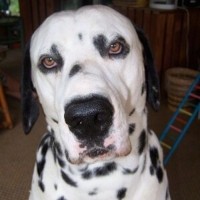Appearance of the Dalmador
|
| The Dalmador will display some of the famous Dalmatian spots. Some coats will have more spots than others, usually in patches on a dark, solid coat. Labrador heritage means that not all coats will be the classic white and black of the Dalmatian. The Dalmador has a strong, muscular, perfectly proportioned body, a deep chest and strong, straight front legs with compact, rounded hind legs. The tail is long and pointed. Their head is slightly rounded at the top and their ears are folded and stretched to the side of their head. Their long snout features a black nose with wide nostrils, and their teeth come together in a scissor bite. Their wide, dark eyes are wide and edged in black, and give the Dalmador an intelligent, expressive expression. |
Temperament of the Dalmador
|
| The mix between the Dalmatian and the Labrador Retriever can produce a dog of variable personality, but often the sensitive nature of the first parent is counterbalanced by the friendly, outgoing nature of the Labrador. The Dalmador's high intelligence makes training easy. For the slightly sensitive dog, reward his efforts with praise and an occasional treat. These dogs are active animals who will happily accompany you on a run, run tirelessly alongside your bike and join in any games the family wants to play. They may have a tendency to bark or howl, but proper training will help prevent this from becoming a problem. They love children, but their size and energy can knock a small child over, so it's advisable to supervise play. Dalmador will make good companions for other pets, often having a protective instinct towards them. These dogs make ideal pets and are content to snuggle up with their families, but can get too big for your lap even though they'll always try to adapt. They are affectionate, caring and good-natured dogs that make ideal family pets. |
Needs and activities of the Dalmador
|
| The Dalmador is an active dog and will love to accompany you for a walk, hike in the countryside, run alongside your bike or simply race along a beach while you watch. Ideally, these dogs should be walked daily, or better still, twice a day to satisfy their need for exercise. A bored dog without outings and exercise can become a vicious dog, getting into things he shouldn't and barking at any movement along your street. In summer, trips to the beach or river are perfect for your Dalmador. They can cool off and get some exercise at the same time. Once they're tired, they'll simply want to curl up and doze beside you. They make devoted, affectionate pets that deserve extra care. |
Maintenance of the Dalmador
|
| Dalmador can be quite soft, so it takes a little extra effort to groom them and remove the hair before covering the house. Often, the coat explodes with the onset of spring and handfuls of hair can be pulled out. A firm bristle brush used three times a week will help maintain its coat. Bathing the Dalmador will help eliminate loose hair and prevent doggy odors. Just be sure to use a shampoo designed for dogs to avoid any allergic reactions. Your Dalmador will benefit from all your attention, and if you start when he's very young, it will become a precious moment of complicity. Don't forget to check inside their ears as infections can become a problem; wiping the ear will help remove debris. Their nails may need trimming unless they're active enough to wear them out themselves. Ask your dog groomer to show you how to do it properly if you've never done it before, to avoid cutting too low and hurting your dog. And finally, if you brush your dog's teeth regularly, you can prevent breath and any tooth and gum problems. |










 English (United Kingdom)
English (United Kingdom)